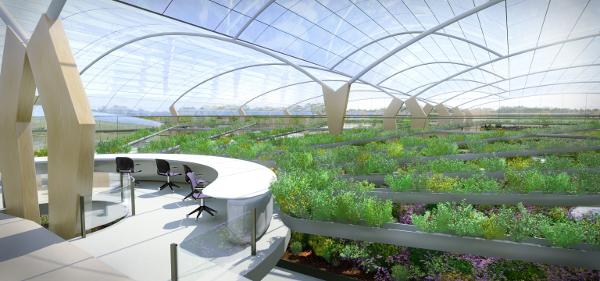With an expected two billion more mouths to feed by 2050, the world needs to learn how to grow more food on less land.Over the last century, agriculture has intensified, dictating global diets, reducing biodiversity andcontributing to global warming. With more mouths to feed every day, two recent EU feasibility studies have shown that high-yield indoor farms could be the missing link in achieving a sustainable food chain.The IssueAround a sixth of all global greenhouse gas emissions come from agricultural production.Prioritisingsustainable food productionwill help feed Europe’s population and enable Europe to achieve its target of reducing 1990 CO2 emissions levels by 80 % to 95 % by 2050.To reach this end, the EU has put togetherThe Roadmap to a Resource Efficient Europe, which looks at ways to lower the environmental impact of food production and consumption, and launched theSME instrumentto help small- and medium-sized enterprises optimise food production.‘The way our food is grown, harvested, distributed and delivered to our plates, is an incredible, wasteful and energy-intensive cycle,’ said Tom Bosschaert, Director of Except Integrated Sustainability, an organisation developing innovative sustainable solutions, among which are farming systems.‘We collected a group of scientists and studied how we could use some of the principles of permaculture to come up with an industrialised natural food system,’ said Bosschaert.With Except, he invented the Polydome which is a type of greenhouse using complimentary crops and animals in a mini ecosystem. The relationship between these plants and animals maximises production while all waste is reused within the system, eliminating the need for artificial fertilisers.The Polydome has potential yields of 60-90 kilogrammes per square metre, diverse outputs of over 50 crops including mushrooms, chickens, eggs, fish, and honey, and can provide pesticide-free food for 3 000 to 5 000 people per hectare each year.To put that into context, the current EU average yield per hectare for single cultures of wheat is 0.56 kilogrammes per square metre, while for potatoes it’s 3.16 kilogrammes per square metre, according toa reportby the EU’s in-house science service, the Joint Research Centre.Indoor farming like this can also greatly reduce water use and emissions compared with conventional farming, but with the business model for these systems yet to be widely tested we’re still some way from another agricultural revolution.Proof of conceptHowever, an EU-funded feasibility study has already been caried out in Arkna, Estonia, to explore the possibility of setting up a commercial Polydome on a one hectare site.‘We met with different stakeholders at the municipality level and the county level. We talked to horticulture associations, supermarket chains, we visited markets and talked to local people,’ said Nele Rogenbaum, project coordinator of the Polydome Arkna project.‘We found that a Polydome is feasible and our investments would be returned within seven years.’“‘They’re not going to be the solution to solve all the world’s food problems, but it’s one of the main ingredients to help us get there.’Márton Kenyeres, CEO, BIOPOLUS TechnologiesWhat’s interesting about the Estonian feasibility study is that Polydome’s sustainable credentials would spread to a neighbouring dairy farm, normally not the greenest industry, as the manure from 500 cows will be used for biogas.This is particularly important considering Estonia doesn’t have much daylight and is very dark for several months in a year, meaning the Polydome’s artificial lights can be powered by sustainable energy while simultaneously extending the country’s growing season.One of the most promising factors of indoor farms are their ability to adapt to different environments, markets or tastes and create a sustainable link in the local food chain.‘In every country the food basket has grown so much, it’s grown global,’ said Rogenbaum.‘What people eat in their everyday life is often imported from far away, so why not find a way to grow them closer and not build up all those food miles?’As more and more of our food is produced abroad, often from outside Europe, we also increase our vulnerability to disruptions in the supply chain.‘I was in Paris during the volcanic eruption in Iceland when all European air traffic was stopped. In under two weeks the shelves were empty in many stores and restaurants had to remove certain dishes from their menu,’ said Márton Kenyeres, chief executive of BIOPOLUS Technologies.Urban farmKenyeres is part of an EU-funded feasibility study aiming to bring a high-yield, highly automated aeroponic plant cultivation system to dense urban environments.‘We are looking at ways to pack the most plants into the smallest area because space in cities is often expensive or scarce,’ said Kenyeres.Aeroponic technology grows plants without soil by spraying a nutrient-rich liquid over the plants’ roots instead.This type of system stacks rows of plants on top of each other and uses only a fraction of the water compared to conventional farming. It also provides year-round crop production and removes the need for pesticides or fertilisers.(Article continues after the image)Aeroponics is one way to grow plants indoors.‘The aim of this project was to come up with a list of options that can be produced using this system and to fine tune all these parameters – like how much water is required for a given plant, what are the ideal light conditions of different phases of plant growth and what are the best compositions of nutrient solution,’ said Kenyeres.‘But the most important part was to assess the market for the technology itself.’A research team conducted a customer survey and interviewed chefs and restaurant owners in Hungary to determine if there was a demand for aeroponic produce.Kenyeres estimates that an aeroponic farm of 500 square metres can supply 100 tons of fresh and high-quality food to local markets each year.‘We believe this is feasible,’ said Kenyeres. ‘Our plan now is to submit a proposal for the second phase of theSME instrument(an EU initiative to fund small, innovative companies) to build an actual pilot facility.’With feasibility studies now supporting both aeroponic systems and Polydomes, it’s making more and more sense to develop indoor farms. And, according to Bosschaert, these next generation greenhouses may just be the missing link in achieving a sustainable food system.‘They’re not going to be the solution to solve all the world’s food problems, but it’s one of the main ingredients to help us get there.’
This article was originally published in Horizon, the EU Research and Innovation magazine.
Add to favorites:
Favorite
Share:
Under the dome – multi-storey farms bring crops, livestock indoors
Listing Description
Documents
No documents available.
Video
Contact the listings owner
Connect with the Listing Owner!
💬 Please log in now to send a direct message to the listing owner. Not a member yet? Sign up for free and start connecting today!
Related Funding and Finance Opportunities
Unlock Exclusive Funding Opportunities!
🔑 Get instant access to tailored funding opportunities that perfectly match your needs. This powerful feature is exclusively available to our premium members—helping you save time, stay ahead of the competition, and secure the right funding faster.
Upgrade to Premium now and never miss an important opportunity again! Already a premium member? Log in here to explore your matches.

